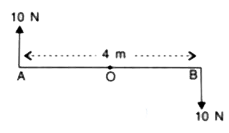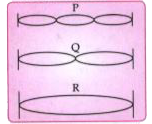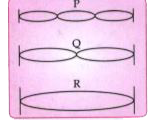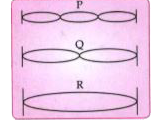Complete Solutions to SECTION-II of chapter SAMPLE PAPER 2014 of Class 10 book with complete answers and questions
| Class 10 | PHYSICS |
| Chapter | SAMPLE PAPER 2014 |
| GURUKUL | SECTION-II |
| Number Of Questions | 39 |
| Academic Year | 2023-24 |
A man having a box on his head, climbs up a slope and another man having an identical box walks the same distance on a levelled road. Who does more work against the force of gravity and why?
View SolutionThe forces each of magnitude 10N act vertically upwards and downwards respectively at the two ends A and B of a uniform rod of length 4m which is pivoted at its mid point O as shown is fig. 1.30, Determine the magnitude of the resultant moment of forces about the pivot O.

View SolutionA body is thrown vertically upwards. Its velocity keeps on decreasing. What happens to its kinetic energy as its velocity becomes zero ?
View SolutionDraw a diagram to show how a single pulley can be used so as to have its ideal M.A. = 2.
View SolutionDerive a relationship between mechanical advantage, velocity ratio and efficiency of a machine.
View SolutionLight passes through a rectangular glass slab and through a triangular glass prism. In what way does the direction of the two emergent beams differ and why?
View SolutionRanbir claims to have obtained an image twice the size of the object with a concave lens. Is he correct? Give a reason for your answer.
View SolutionA lens forms an erect, magnified and virtual image of an object.
Name the lens.
View SolutionA lens forms an erect, magnified and virtual image of an object.
Draw a labelled ray diagram to show the image formation.
View SolutionDefine the power of a lens.
View SolutionThe lens mentioned in 6 (b) above is of focal length 25 cm. Calculate the power of the lens.
View SolutionThe adjacent diagram shows three different modes of vibrations P, Q and R of the same string.

Which vibration will produce a louder sound and why?
View SolutionThe adjacent diagram shows three different modes of vibrations P, Q and R of the same string.

The sound of which string will have maximum shrillness?
View SolutionThe adjacent diagram shows three different modes of vibrations P, Q and R of the same string.

State the ratio of wavelengths of P and R.
View SolutionA type of electromagnetic wave has wavelength 50 Å.
Name the wave.
View SolutionA type of electromagnetic wave has wavelength 50 Å.
What is the speed of the wave in vacuum ?
View SolutionA type of electromagnetic wave has wavelength 50 Å.
State one use of this type of wave.
View SolutionState one important property of waves used for echo depth sounding.
View SolutionA radar sends a signal to an aircraft at a distance of 30 km away and receives it back after `2xx10^(-4)` second. What is the speed of the signal ?
View SolutionTwo resistors of `4Omegaand6Omega` are connected in parallel to a cell to draw 0.5 A current from the cell.
Draw a labelled circuit diagram showing the above arrangement.
View SolutionTwo resistors of `4Omegaand6Omega` are connected in parallel to a cell to draw 0.5 A current from the cell.
Calculate the current in each resistor.
View SolutionWhat is an Ohmic resistor ?
View SolutionTwo copper wires are of the same length, but one is thicker than the other.
(1) Which wire will have more resistance ?
(2) Which wire will have more specific resistance ?
View SolutionTwo sets A and B, of three bulbs each, are glowing in two separate rooms. When one of the bulbs in set A is fused, the other two bulbs also cease to glow. But in set B, when one bulb fuses, the other two bulbs continue to glow. Explain why this phenomenon occurs.
View SolutionTwo sets A and B, of three bulbs each, are glowing in two separate rooms. When one of the bulbs in set A is fused, the other two bulbs also cease to glow. But in set B, when one bulb fuses, the other two bulbs continue to glow. Why do we prefer arrangements of Set B for house circuiting?
View SolutionHeat energy is supplied at a constant rate to 100 g of ice at `0^(@)C`. The ice is converted into water at `0^(@)C` in 2 minutes. How much time will be required to raise the temperature of water from `0^(@)C" to "20^(@)C` ? [Given : sp. Heat capacity of water `4.2g^(-1)""^(@)C^(-1)`, sp. latent heat of ice = `336Jg^(-1)`]
View SolutionThe specific heat capacity of a substance A is `3,800Jkg^(-1)K^(-1)` and that of a substance B is `400Jkg^(-1)K^(-1)`. Which of the two substances is a good conductor of heat ? Give a reason for your answer.
View SolutionSpecific heat capacity of substance A is `3.8Jg^(-1)K^(-1)` whereas the specific heat capacity of substance B is `0.4Jg^(-1)K^(-1)`.
How is one led to the above conclusion ?
View SolutionSpecific heat capacity of substance A is `3.8Jg^(-1)K^(-1)` whereas the specific heat capacity of substance B is `0.4Jg^(-1)K^(-1)`.
If substances A and B are liquids then which one would be more useful in car radiators ?
View SolutionState two ways to minimise the impact of global warming.
View SolutionWhat is the greenhouse effect?
View SolutionName two factors on which the magnitude of an induced e.m.f. in the secondary coil depends.
View SolutionIn the following diagram an arrow shows the motion of the coil towards the bar magnet.
(1) State in which direction the current flows, A to B or B to A ?
(2) Name the law used to come to the conclusion.

View SolutionA nucleus `""_(11)Na^(24)` emits a beta particle to change into Magnesium (Mg).
Write the symbolic equation for the process.
View SolutionA nucleus `""_(11)Na^(24)` emits a `beta`-particle to change into magnesium (Mg).
What are numbers 24 and 11 called?
View SolutionA nucleus `""_(11)Na^(24)` emits a beta particle to change into Magnesium (Mg).
What is the general name `""_(12)^(24)Mg` with respect to `""_(11)^(24)Na` ?
View SolutionIn a cathode ray tube state :
the purpose of covering cathode by thorium and carbon.
View SolutionIn a cathode ray tube state :
the purpose of the fluorescent screen.
View SolutionIn a cathode ray tube state :
How is it possible to increase the rate of emission of electrons.
View Solution
SECTION-II questions and complete solutions for chapter SAMPLE PAPER 2014 of SELINA PHYSICS (ENGLISH) of Class 10